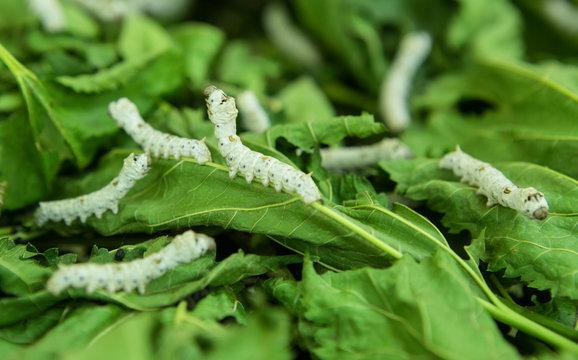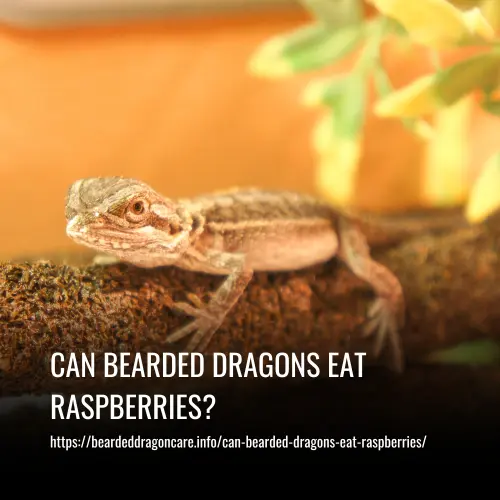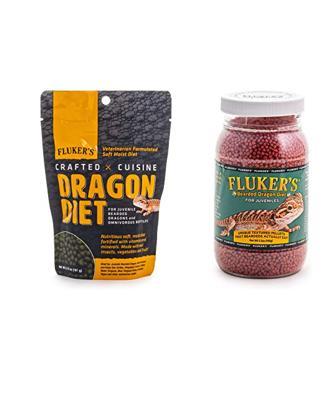Silkworms, also called ‘silkies’, are the larval (or caterpillar) stages of the Mulberry silkmoth (Bombyx mori). They are generally cultured privately on a small scale or commercially on farms for their ability to produce silk. With their high protein and relatively low-fat content, silkworms are considered to be amongst the best insect foods for Bearded dragons.
Although their natural life cycle is seasonal, silkworms are easy and relatively cheap to keep and culture. Other than food items for Bearded dragons and other reptiles, silkworms are popularly cultured on large scale for their ability to produce silk.
In some countries, silkworms are readily available from specialized pet shops and online retailers (Buy live silkworms from Amazon.com ). Silkworms are quiet, slow-moving, fairly odorless, and need little maintenance and relatively small amounts of space.

What Are Silkworms?
Silkworms are actually the caterpillar stage of the Bombyx Mori moth, and it is originally from China. Humans have a special interest in silkworms because they produce silk. This material is used to create a cocoon which transforms into a moth. Depending upon its size and diameter, the cocoon of a silkworm has an average length of 300-900 meters.
Aside from being integral to the textile industry, silkworms also serve another purpose—they are considered a delicacy in some areas of Asia. In addition, they make great insect food, especially for Bearded Dragons and other reptiles.
Silkworm sizes
- Hatchling / first instar 3 mm
- Second instar 9 – 19 mm / 3/8 – 3/4 ” (small silkworms)
- Third Instar 19 – 31 mm / 3/4 – 1 1/4″ (medium silkworms)
- Fourth instar 31- 44 mm / 1 1/4 – 1 7/8 ” (large silkworms)
- Fifth instar 50 – 75 mm / 2 – 3 ” (x-large silkworms)
- Moth has a wingspan of 40 to 50 mm / 1.5 “
Silkworm life cycle
Silkworms hatch from eggs produced by Mulberry silkmoths. After hatching, a silkworm will grow through several larval stages before pupating and emerging as a silkmoth again.
The life cycle of silkworms (Bombyx morio). Image by B kimmel (CC BY-SA 4.0)
Newly hatched silkworm larvae are very tiny and will eat for anything between 12 and 56 days, consuming large amounts of mulberry leaves. The time it takes a silkworm to grow is dependent on the environmental temperature and the availability of food. Colder temperatures will prolong this period and vice versa. During their growth period, they will molt four times. The times between their moltings are called instars. The larvae of all four of these stages (collectively called silkworms), can be fed to Bearded dragons.
After the last molting and being about 50 to 75 mm / 2 to 3 “, the silkworm will stop eating and create a cacoon from its own silk. Metamorphosis (changing into a moth) will take two to three weeks to complete. Moths that emerge from the cocoon will not eat at all. Their only goal is to find a moth of the opposite sex, breed, and lay eggs again. A female silkmoth can lay anything from 200 to 500 eggs. Silkmoths are generally not fed to Bearded dragons.
Can Bearded Dragons Eat Silkworms?
Bearded dragons can certainly eat silkworms, and they offer several important benefits. Silkworms have good moisture content and are high in protein, making them excellent food for baby bearded dragons.
They’re also ideal for adult bearded dragons because they offer great nutrition, although you may need to feed lots of them to your adult bearded dragon for it to be satisfied.
Do Bearded Dragons Like To Eat Silkworms?
The answer is yes! Bearded dragons love to eat silkworms, which are high-quality, nutritious food. They’re packed with protein and essential vitamins and minerals that bearded dragons need to stay healthy. However, it’s important to not overfeed them as silkworms have very high levels of fat and low levels of fiber.
Bearded dragons can enjoy silkworms as part of their diet – they should only make up 10 percent or less of their total diet though. This means that the other 90 percent needs to be composed of more balanced sources of nutrition like leafy greens, vegetables, insects, etc.
Are Silkworms Good For Bearded Dragons?
Yes, silkworms are great food for bearded dragons! They are high in protein, vitamins, and minerals. This makes them an excellent choice as a compliment to the other types of foods you should be feeding your pet reptile.
Of course, it’s important to give your bearded dragon a variety of fruits, vegetables, and insects to make sure they get the most complete nutritional diet possible.
Advantages of Silkworms For Bearded Dragons
Silkworms are an excellent food source for bearded dragons. Not only do they provide nutrition, but there are a number of additional advantages for including them in your dragon’s diet.
One of the main benefits of feeding silkworms to your dragon is that they have very good nutritional values. They are high in protein and fat, and their soft bodies make it easy for dragons to digest them quickly. This makes them great for both babies and adults alike.
Silkworms are also very quiet compared to other insects, so you don’t have to worry about complaints from neighbors or scared family members! Another perk is that they’re very easy and hardy to keep; plus, since they don’t smell bad there’s no need to worry about odors around your pet.
Finally, unlike some other insects such as crickets or locusts, silkworms won’t bite or attack your bearded dragon. That means you can feel confident that they won’t be hurting your beloved pet while they feed on the worms.
Silkworm nutritional values*
Silkworms offer great value as food for Bearded dragons. When looking at their nutritional composition, they are high in protein, vitamins, calcium, and other minerals and low in fat:
- Moisture 20% (5)
- Total protein 59% (5) (17)
- Total fat 17% (5) (17)
- Calcium: Phosphorus ratio 1:2 (13)
* Values are averages calculated from sources. Expressed as %DM except for moisture.
When comparing silkworms with other crawling food such as mealworms (T. molitor), they have similar amounts of protein (ca. 59% (5) (17) vs. 54% (1) (2) (4) (5) (6) (8) (9) (14) ), less fat (ca. 17% (5) (17) vs. 30% (1) (2) (5) (6) (7) (8) (9) (14) ), more usable calcium (Ca:P ratio of about 1:2 (13) vs. 1:14 (5) (6) (8) (9) (11) (14) (18) ) and are just as tasty. When compared to crickets (A. domestica), silkworms have similar protein levels (ca. 64% (3) (5) (6) (8) vs. 59% (5) (17) ), less available calcium (ca. 1:5 (6) (8) (18) vs. 1:2 (13) ) and similar amounts of fat (21% (3) (5) (6) (8) vs. 17% (5) (17) ).
The Health Benefits Of Silkworms For Bearded Dragons
Eating silkworms can provide a range of health benefits for bearded dragons. Silkworms are an excellent source of protein that contains important vitamins and minerals, such as vitamin A, vitamin B12, and calcium. These nutrients can help your dragon stay healthy and strong.
Silkworms should not be the staple food of your bearded dragon’s diet, but they do make a great occasional treat to provide a boost in nutrition. Knowing the types of benefits that come with eating this tasty insect is essential in keeping your furry friend happy and healthy!
In addition to protein, Vitamin A helps keep your dragon’s eyesight strong while B12 boosts energy and aids in digestion. Calcium is also important for skeletal development so feeding silkworms regularly will give your bearded dragon the perfect mix of beneficial vitamins and minerals that they need to remain active and energetic.
Overall, adding silkworms into your bearded dragon’s diet is one way to ensure they maintain their long-term health. Don’t overdo it though; feed them occasionally as a special treat for maximum benefits!

Disadvantages of Silkworms For Bearded Dragons
When it comes to feeding your bearded dragon, you may be wondering if silkworms are a good choice for them. Unfortunately, there are some risks associated with feeding silkworms to bearded dragons that you should be aware of before doing so.
Firstly, silkworms can be difficult to digest and can potentially cause blockages in the bearded dragon’s digestive system. Additionally, unprocessed or wild-caught silkworms can contain parasites such as mites and nematodes (roundworms) which can make your bearded dragon very sick.
To ensure that these parasites aren’t passed on to your pet, soak the silkworms in a salt bath (1 tbsp of sea salt per cup of water) for 5 minutes then dry well before feeding them to your bearded dragon. Another option is to feed commercially raised insects that have been fed an insect-only diet free of pesticides and parasites.
Finally, take note that silkworms are quite high in fat and can contribute to obesity if your beardie eats too many of them! Always feed them in moderation as part of a balanced diet for optimal nutrition.
How To Safely Feed Your Bearded Dragon Silkworms
Bearded dragons are omnivores, meaning they consume both plant-based and animal-based foods. Silkworms are a great source of protein for your beardie, but it’s important to make sure you’re feeding them safely.
First, always be sure to only give your bearded dragons cooked silkworms. Raw silkworms can contain harmful bacteria that can make your beardie sick, so always make sure they’re cooked before serving them up.
You should also limit the number of silkworms you feed your bearded dragon each day – too many worms can upset their stomachs. After 20 minutes or so, be sure to take away any uneaten worms as these can also become dangerous if left around too long.
Feeding silkworms to Bearded dragons
When available, silkworms can be fed to any size and age Bearded dragon. They are considered palatable (tasty) and are readily accepted by Bearded dragons and other insectivorous reptiles (making them a great choice for picky eaters too). Silkworms have soft bodies that make them easy and safe to swallow and digest. Because of their high protein and available calcium levels, they are popularly fed to gravid female and growing Bearded dragons.
How Many Silkworms Should I Feed My Bearded Dragon?
When deciding how many silkworms to feed your Bearded Dragon, it’s important to take several factors into consideration.
For adult Bearded Dragons, we recommend you give them silkworms once or twice a week as part of their diet. However, make sure you mix up the diet with other bugs for variety. For younger Bearded Dragons, feeding them silkworms is a great choice and is one of our recommended foods.
To figure out how many Silkworms to give your dragon, offer as much as they can consume within a 10-minute span of time. It helps if you put the Silkworms in a bowl so that they can pick off one or two at a time. By providing the right amount of Silkworms, your bearded dragon will get all the nutrition they need and remain healthy.
Can I Feed Dried Silkworm To My Bearded Dragon?
Although it is technically possible to feed your bearded dragon dried silkworm, there are several reasons why it is not recommended. For one thing, the nutritional value of a dried silkworm compared to its live counterpart is significantly lower. This means that your bearded dragon would not be getting the same vitamins and minerals that they need from its diet.
Another issue is that dried insects contain no water, which can lead to dehydration in bearded dragons. Normally they get most of their water intake from eating live insects, but since this won’t be happening with dried insects, you will need to find other ways to provide them with water such as providing them with fresh vegetables or using a misting system.
Overall, we do not recommend feeding your bearded dragon dried silkworm as it can cause them more harm than good in terms of nutrition and potential dehydration. It is best to stick to live insects for the healthiest diet possible.
FAQs
What kind of live insects can bearded dragons eat?
Your dragon can feed on earthworms, cockroaches, silkworms, crickets, and roaches. Crickets and dubia roaches are among the most favored feeder insects.
What Else You Can Feed Your Bearded Dragon Instead Of Silkworms
Bearded dragons can also eat crickets, mealworms, super worms, waxworms, fruit flies, and hornworms. Fortunately, all of these are safe for them.
What is the best live insect to feed a bearded dragon?
Crickets, which provide essential protein and calcium, tend to be attractive for Bearded Dragons and are typically easily accessible from pet stores or online.
Conclusion
In conclusion, feeding live silkworms to bearded dragons can be a great way to provide your pet with variety, nutrition, and stimulation. They are safe, nutritious, and easy to care for; an ideal addition to the diet of any dragon! Just remember that you should always monitor your pet when they are eating live insects in case of potential choking hazards or illness.
With our guidance and advice, you should have no trouble providing your bearded dragon with the best nutrition possible – including the occasional treat of live silkworms!

